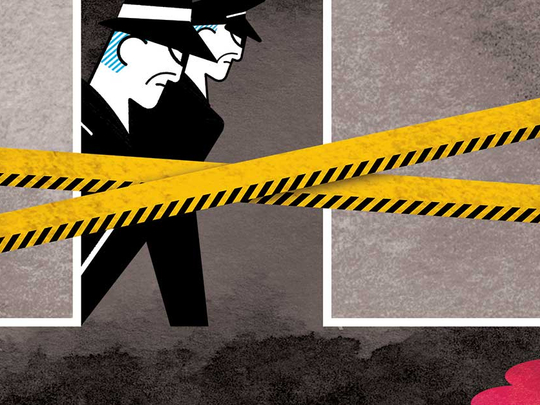
The Trespasser
By Tana French, Viking, 464 pages, $27
Tana French, the superb Irish novelist who happens to write avidly about crime, used to link her books by having a minor character in one become the beleaguered protagonist of the next. Since the books all involved the Dublin Murder Squad, the beleaguered part came easily. But in her sixth novel, “The Trespasser”, she breaks that pattern to reunite the same pair of detectives who waded through “The Secret Place”, her fifth. That one took place at a swanky private school, a grating milieu where the girls’ teen language (“Um, duh?”) wasn’t easy for the detectives, Antoinette Conway and Stephen Moran, to take.
Conway and Moran survived this hazing so well that French has paired these two off again. And why not? Moran (deemed “totes adorbs” by the schoolgirls) is the perfect foil for Conway, and each has come to know and respect the other’s tricks. At the start of “The Trespasser”, they have been acquainted for eight months and partnered for only four, but they’re feeling out each other and the process is working. Conway explains to the reader: “At first I didn’t like him — everyone else did, and I don’t trust people who everyone likes, plus he smiled too much — but that changed fast.” The barbed thing about that observation is it’s equally astute about both characters.
One of French’s great strengths has always been the keen insight with which she endows her characters and the coy distance at which she keeps them from the reader. Her books would be mysterious even if they didn’t involve outright murders. The people in them keep secrets, imperceptibly change, create façades, hide motives and, as she illustrated so brilliantly in “Faithful Place”, even fool their own families about matters of life or death for decades. That remains the most stunning of her books, but this new one is a tour de force, too.
If “The Trespasser” were described simply via its plot, it might sound like an ordinary police procedural. In fact, Conway and Moran are disappointed as the book begins, having been handed what sounds like a garden-variety murder case to solve. A good-looking young woman named Aislinn Murray is found dead in her apartment on a Saturday night. The table is set for two, and dinner is shrivelling in the kitchen. She appeared to have a date with a bookstore owner named Rory Fallon, and she evidently died from a blow to the head. So either she fell and hit her head on the fireplace, or Rory came over and hit her. End of story?
Just wait for these stunningly obvious hypotheses to fall apart. The first sign that something is wrong is the attitude of Conway’s peers, who haze her tirelessly and have raised the ante now that she has the Murray case to solve. One overbearing detective, an imposing character named Breslin, is unusually eager to nail Rory for the crime and close the case immediately. And in the interrogation room scenes that are great specialities of French’s, Rory emerges as a peculiar guy. In a book by this author, anyone would. In any case, Conway and Moran don’t take their orders from Breslin and let him know it.
“The Trespasser” is brisk but not breathless. It would be a pity if French raced through such beautifully conceived and executed material. When it comes to grilling suspects, Conway gets such a high from the process that the reader can almost feel it. And just the idea of Conway’s picking the personality she will use to question a particular suspect (she likes Cool Girl for Rory) says something about the effort that goes into her work. She’s a pro who takes no nonsense from anyone, and while Rory seems harmless enough, there’s something about him that makes the smell of blood hit the back of her nose. She’s also sure that she has met Aislinn somewhere and that Aislinn wanted something from her.
When you read French — and she has become required reading for anyone who appreciates tough, unflinching intelligence and ingenious plotting — make only one assumption: all of your initial assumptions are wrong. This author drops just enough breadcrumbs through her book to create trails that lead away from whatever the detectives’ conventional wisdom happens to be, and she doesn’t follow up on them until she’s good and ready.
So it’s indicated early on that there was something odd about Aislinn. She wasn’t always Barbie-doll pretty, and it took a lot of work for her to remake herself into some kind of retrograde vision of femininity. Indeed, after Conway has finished searching Aislinn’s house, she goes home to her own glancingly similar place and feels grateful not to own gingham curtains. It’s also hinted that Aislinn might have been just the kind of girlfriend a gangster could love.
The prospect of scheming between gangsters and overeager cops arises early in the story. And it suggests how abundant Conway and Moran’s potential enemies may be. Moran has wonderful wiles, but it’s Conway’s loud, fearless mouth that gives this book much of its power, as when Breslin tries to take the investigation away from her outright, telling her that she needs to calm down and bear in mind that he has a lot more experience than she does. “If I do something, I think you can take it on trust that it’s in the best interests of the investigation,” he tries to say soothingly.
Knowing full well that Moran would like her to shut up and move on, Conway digs in her heels. “I’m bearing nothing in mind,” she replies. “Unless I missed your promotion, we’re on the same squad, and this is my investigation. Which means you’re the cheeky little [expletive] who’s getting above himself, and you’re the one who needs to bear in mind who’s who here.”
Fair play to you, Detective Conway, for getting the better of whoever gets in your way.
–New York Times News Service









